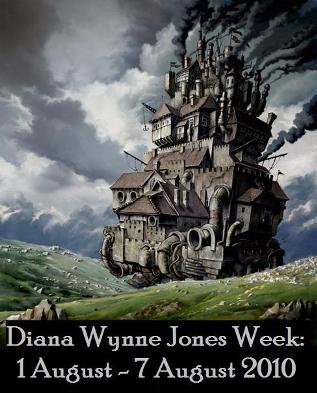Although I have charming matched blue copies of the Dalemark Quartet, the four books in this series are not among my favorites by Diana Wynne Jones. Why then, you ask, have I chosen the Dalemark Quartet as the only books to be properly reviewed during Diana Wynne Jones Week? Mainly for the exact reason that I have not loved them in the past–I wanted to give them another chance. Another reason is that they are among Diana Wynne Jones’ early YA-fantasy books, and I like seeing writers in progress. Hearts.
In Cart and Cwidder, we meet Moril, the youngest son in a family of Singers that travels around Dalemark playing in any town they happen on. Dalemark is divided into fifteen earldoms, which are further divided into North and South Dalemark; when Moril’s family travels in the South they have to remember to be careful of what they say, for fear they will be called traitors and cast into prison. Which is kind of what happens. To help his family, Moril must use his father’s cwidder, an ancient and (in this case) mythic musical instrument whose power Moril barely understands.
Drowned Ammet takes place before Cart and Cwidder, and follows a separate set of characters, although there is some overlap in time and events. Mitt is the son of a Southern freedom fighter; when his father is betrayed by his fellow freedom fighters, Mitt vows to grow up to avenge him. He gets his chance when he is fourteen, at the annual parade to honor the folk gods Old Ammet and Libby Beer; when this goes horribly awry, he stows away on a little pleasure boat owned by the grandchildren of the Earl, Hildy and Ynen. Class tension hilarity ensues.
Can we just take it for granted that everything I say this week should be prefaced by “I love Diana Wynne Jones and”? Everything. (I love Diana Wynne Jones and) I shall now talk about the Dalemark Quartet. (I love Diana Wynne Jones and) this is my week for learning about how copyrights work. (I love Diana Wynne Jones and) it’s hot outside. Thank you.
Though these books occur fairly early in Diana Wynne Jones’s writing career, she is already writing many of the themes that will recur over and over again in later books. Particularly for Moril, but hardly less so for Mitt, self-knowledge is crucial. Mitt and Moril spend a lot of time lying, whether deliberately (Mitt deceives the freedom-fighters into believing he is loyal to them) or by circumstance (Moril does not know about any of his father’s, shall we say, extracurricular activities, until well into the book). As much as their lies have protected them, it’s made clear that they cannot carry on lying to themselves, or to the people they trust. Moril cannot make the cwidder work for him, nor Mitt work out how to proceed after becoming a wanted criminal, until each of them has confronted the truth about himself and those around him.
Another common plot element of Diana Wynne Jones’s books is the thing of stories and myths coming true. It happens to Moril and it happens to Mitt. The myths start coming to life around them, whether they believe in them/understand them/want them true or not. What I like about these books as companions to each other is that while the boys live in the same country, they occupy completely different worlds, and they live by different myths. Far from making the books feel disjointed, the side-by-side mythologies expand the world of Dalemark–a traveling Singer would have different legends than a gutter boy of the South Dales.
As I remembered from previous readings, the writing and plotting in these books is not as tight as in some of Jones’s later books–Drowned Ammet peters off rather anticlimactically. I had intended to read these two for DWJ Week and worry about the second two some other time. But when I got through with these two, I found myself unable to remember what happened in the second two books and very unhappy about it. If not Diana Wynne Jones at her peak, they are still very worthy contributions to her canon.
